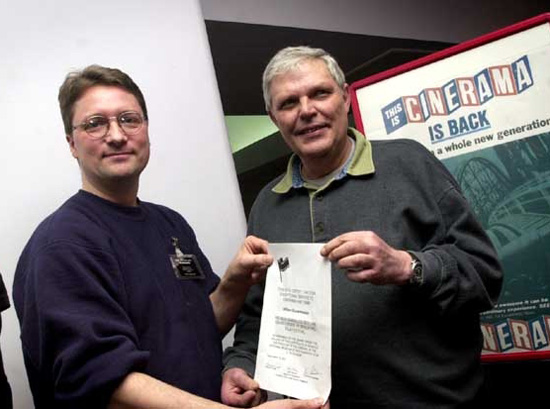2003 Academy Member
|
Read more
at in70mm.com The 70mm Newsletter |
| Written by: Howard Rust | Date: March 2003 |
 Mr.
Willem Bouwmeester accepting the 2002 certificate from Thomas Hauerslev.
Picture by Jim Moran. Mr.
Willem Bouwmeester accepting the 2002 certificate from Thomas Hauerslev.
Picture by Jim Moran.For those of us who are able to recall three strip Cinerama the first time around, the initial impact that it made on each of us can instantly be recalled … the city … the cinema … even the seat location. The subsequent rash of 70mm movies projected on to existing curved screens and marketed as “in Cinerama” were just not the same. Somehow, in the late sixties, wide screen movies lost their magic, and Cinerama became a fondly remembered memory of our movie-going experience. We knew that we would never see it again. Then came IMAX and in 1983 the only place to see it in Britain was here in Bradford, in this superb “museum of photography”. IMAX was - and is – impressive, but for many of us it brought back memories of it’s forerunner … Cinerama. In 1993 the museum incredulously announced that it intended to include an authentic, three projector, seven track sound, Cinerama installation as its newest attraction. And the film was to be… unbelievably …”This is Cinerama”. How could this be? When the owners of the Cinerama company decided to close down, the word went out that everything had to be destroyed, the projectors, the sound system, the films … all must be scrapped. However, around the world, there were individuals who just could not allow this to happen. The recipient of our award of inclusion to “The Academy of the Widescreen Weekend” is such a person. At the age of fourteen, his father took him to see Cinerama. That did it. His role in life was defined. He had to be “something technical in the cinema” and maybe some day, somehow, he would be able to re-create “The Cinerama Experience”. In 1992 he discovered that this museum was seeking a new attraction to add to it's collection. For him the logical choice could only be Cinerama. He approached the then head of the museum with his proposal; who, after delicate and intense negotiations with the city of Bradford for the acquisition of the adjoining repertory theatre in which we are now sitting, gave him the go-ahead. Thus, recipient embarked upon the enormous task of tracking down, and locating, the almost non-existent components necessary to re-create an authentic Cinerama installation. By happy chance, the museum already had two Cinerama projectors. These had to be restored to the unique six-perforation “pull-down” and the discarded “gigolos” re-installed. He set to work and did the job himself. A third projector was located in Glasgow and shipped to Bradford. The company that made the louvers for the original screens searched their store rooms and found a complete set. Unfortunately, these proved to be too short. The search for another supplier was resumed, and one was eventually located in the United States. The metal clamps that hold the louvers in position around the 146 degree curve came from Belgium. Each one of them … at the top and the bottom of the screen … had to be re-drilled in order to hold the louver at the correct angle facing the audience. The screen has 1360 louvers. The seven track sound reproducer was discovered in Finland. Gradually after successfully surmounting dozens of unexpected problems, and with unrelenting persistence and determination, the cinema in which we are now celebrating the 50th anniversary of Cinerama was created. World wide interest was stimulated and the Pictureville pilgrimage began. The man largely responsible for this Cinerama restoration is with us today. I am delighted to invite him to join “Academy of the Widescreen Weekend” Willem Bouwmeester |
Further
in 70mm reading: Wide Screen Weekend home Academy of the Wide Screen Weekend Wide Visit With Willem Bouwmeester in70mm.com's Cinerama page Projecting Cinerama @ the Pictureville On the Trail of "Windjammer" - A Visit to Oslo Cinerama Afterglow - A Get Together in Dayton, OH Historical Wide Screen Gathering This is Oyster Bay Internet link: |
| Go: back
- top - back issues
- news index Updated 22-01-25 |
|
